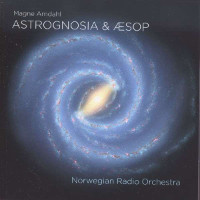| Review by larsmusik June 20, 2015 (5 of 5 found this review helpful)
|
|
The Norwegian composer Magne Amdahl (b. 1942) has enjoyed a lengthy, varied career in his native country. His work encompasses television commercials, a piano concerto and other orchestral music, chamber works, film scores, and an enormous amount of incidental music for theatrical productions. The latter was undertaken in Amdahl’s thirty years as music director at the Oslo Nye Teater and freelance musician for other theatre groups in Oslo. He has won several prizes for his compositions from Norwegian and/or Scandinavian professional music associations.
This new release from Morten Lindberg’s 2L label features two of Amdahl’s colorful, characteristic orchestral works, Astrognosia (1991) and Aesop’s Fables (2012). Astrognosia consists of twelve vignettes, all but one lasting less than two minutes, representing the traditional signs of the zodiac. They are preceded by a brief Preludium, interrupted by three very brief Interludia, and concluded with a slightly longer Pavane. Amdahl’s long experience with the exigencies of film and theatre music has served him well here. For each of the astrological symbols, he quickly sketches something allusive, introducing a theme, color, or rhythm; varying it slightly; and reaching a degree of culmination before moving on. These movements would all make effective film or theatre cues. If extended slightly, some would be useful as ballet music. Amdahl’s style throughout might conveniently be described as accessible post-Romantic: his orchestral scoring reveals a familiarity with Ravel, while some of his harmonic vocabulary derives from early Stravinsky. Little of it would seem out of place in a classic Alex North or John Williams film score. He uses the color and power of a large orchestra to good effect but is also able to suggest a mood with two or three solo instruments. For the most part his writing avoids cliché, although the suite taken as a whole shows a strong reliance on triple meter (suggesting the swirling stars at night?) or, when duple is taken up, simple “marching bass” patterns. To my personal taste, there is little here that feels distinctive or fresh, but I was never bored.
Aesop’s Fables is a work for narrator and orchestra in one continuous movement of 23 minutes. The text is taken from Herman Wildenvey’s Norwegian verse “translation” of Aesop, published with illustrations by Albert Jaern and widely circulated during Amdahl’s childhood years. In his program booklet notes, the composer tells us that he re-engaged with the Wildenvey versification at the age of 70 and immediately recognized its richness. Working with distinguished actor Dennis Storhøi, Amdahl selected and ordered a group of the fables, along with poems that relate Aesop’s life story, which he then set as a more-or-less continuous monodrama. Storhøi provides the able narration in this recording. Is this a children’s work? Perhaps—Amdahl often provides a musical “punch line” for individual fables, making the story and its moral easy to absorb even for less-than-clever children. On the other hand, the fables seem to have been selected for their moral ambiguity. Sometimes the strong animal triumphs, sometimes the weak one outwits him. Sometimes not--clever children will welcome that.
A drawback is the use of Norwegian, of course. Unless you are fluent in the language, you may have a rough time following the fast-paced narration. The booklet provides a complete English translation of the words alongside the original.
By now the essential features of Morten Lindberg’s production technique should be familiar. He and producer Wolfgang Plagge recorded this album in Oslo’s A-frame Jar Church, which he has used previously. Photos of the sessions are included, as well as a seating and mic placement chart. As usual, the engineering has superbly captured both the massed orchestral effects and delicate colors created by individual instruments. The Norwegian Radio Orchestra and conductor Ingar Heine Bergby deliver the goods faultlessly and in the manner of a crack film-studio ensemble.
In preparing this review, I listened primarily to the multichannel SACD tracks.
|
Was this review helpful to you?
yes |
no
|
|

